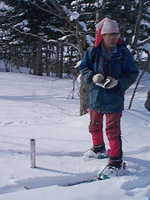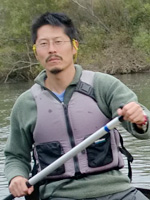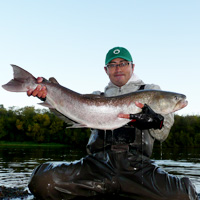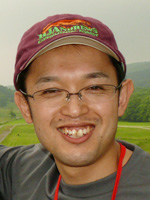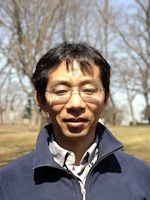Faculty member
<Forest Environment and Function Research>
TAKAGI Kentaro /
Professor
Forest
Environment and Function Research
[Research Topic]
Forest carbon cycle

[Keywords]
, Forest micrometeorology, Ecosystem ecology, Carbon cycle,
Climate change, Disturbance
[Contact] (Replace "*" with "@" when sending
email.)
kentt*fsc.hokudai.ac.jp
[Message]
Research topics: Effect of forestry activities on carbon
& water cycles; Effect of global warming on soil
respiration; Inter-site comparison of carbon cycles of Asian
forests; Regional scale evaluation of forest carbon cycle
Top
of This Page
NOMURA Mutsumi /
Assistant Professor
Forest
Environment and Function Research
[Research Topic]
Hydrological processes in snowy forests

[Keywords]
, Forest hydrology, Snow hydrology, River discharge,
Snowmelt, Water budget
[Contact] (Replace "*" with "@" when sending
email.)
nomu*fsc.hokudai.ac.jp
[Message]
Research topics: Snow accumulation and melting processes in
forests of northern Hokkaido; Water budgets and hydrological
processes in forest catchments
Top
of This Page
OHIRA Mitsuru / Assistant Professor
Forest
Environment and Function Research
[Research Topic]
Contribution of forest to stream ecosystem

[Keywords]
forest disturbance, succession, aquatic insect, fish, watershed management
[Contact] (Replace "*" with "@" when sending
email.)
mohira*fsc.hokudai.ac.jp
[Message]
“How does forest contribute to stream environments and assemblages?” is my fundamental research question.
I examine responses of stream assemblages to forest disturbance, succession, and management with evaluating changes of forest conditions and functions.
I also explore the contributions of forest to downstream and the related watershed-scale management.
Top
of This Page
<Biodiversity Research>
AGETSUMA Naoki / Professor
Biodiversity Research
[Research Topic]
Responses of mammals to natural and artificial disturbances

[Keywords]
, mammal, behavior, disturbance, habitat, adaptation
[Contact] (Replace "*" with "@" when sending
email.)
agetsuma*fsc.hokudai.ac.jp

[Message]
Wildlife species receive various natural fluctuations and
artificial impacts. How does wildlife adapt their ecologies to
these disturbances? From this point of view, I am studying
adaptations of mammal species to these disturbances. I am also
studying the interaction between herbivores and forest
ecosystem by field experiments.
I basically accept students who have concrete research themes
and plans that are suitable for my supervising. If you wish to
receive my instructions in our postgraduate course, send me
your research plans firstly. My students must work in the
facility of our University Forests which locates the rural
city far from Sapporo main campus of Hokkaido University.
Top
of This Page
NAKAMURA Masahiro / Professor
Biodiversity Research
[Research Topic]
herbivore-plant interactions, responses to global warming,
biodiversity and ecosystem function

[Keywords]
, community ecology, global warming, biological
interactions, filed manipulations, biodiversity
[Contact] (Replace "*" with "@" when sending
email.)
masahiro*fsc.hokudai.ac.jp

[Message]
Herbivore insects are the largest group of terrestrial
animals on earth. To understand how herbivore insects respond
to environmental changes, I conduct warming experiments of oak
and birch mature trees (20m in height) using electric heating
cables with collaborators. Moreover, I am very interested in
the effects of species richness of trees (biodiversity) on
variability in forest disturbance from herbivory (ecosystem
function).
Top
of This Page
KISHIDA Osamu / Professor
Biodiversity Research
[Research Topic]
Life history, Phenotypic plasticity, Intraspecific
variation

[Keywords]
, Evolutionary Ecology, Cannibalism, Community Ecology,
Phenotypic plasticity, Intraspecific variation
[Contact] (Replace "*" with "@" when sending
email.)
kishida*fsc.hokudai.ac.jp

[Message]
My research is focused on the ecology and evolution in
biological interactions, in particular the role of phenotypic
plasticity and intraspecific variation of animals in affecting
population dynamics and shaping communities. I am also
interested in adaptive strategy in life history, morphology
and behavioral traits of animals. This work involves
laboratory projects and field research using amphibian larvae.
Top
of This Page
UETAKE Jun / Associate Professor
Biodiversity Research
[Research Topic]
Environmental change and microbial ecosystem

[Keywords]
Microbial ecology, environmental DNA, earth science, environmental change, bioaerosol, glacier, ice nucleation
[Contact] (Replace "*" with "@" when sending
email.)
jun.uetake*fsc.hokudai.ac.jp

[Message]
Invisible microbial life exists in our surrounding environment, such as soil and water,
and that is also in harsh environments such as air, snow, and ice.
Both outdoor fieldwork and indoor lab work( DNA and chemical analysis) enable them to reveal their community structure,
community relationship, and ecology relating to the material cycles.
Moreover, the microbial ecosystem is sometimes powerful enough to change the global environment,
for example, 1: Ice Nucleating organisms, which can promote the ice formation to change the radiation balance in the cloud,
and 2: Glacier melt enhancing organisms, which accelerate the glacier ice melting by reducing radiation reflectance
due to their pigments in the cells.
Therefore, we are collaborating with scientists for earth science and climatologyto tackle the global-scale subject.
Top
of This Page
KURATA Seikan / Assistant Professor
Biodiversity Research
[Research Topic]
Plant taxonomy, Phylogeography, Conservation genetics

[Keywords]
Plant taxonomy, Historical range dynamics, Biodiversity and Conservation, Forests, Semi-natural grasslands
[Contact] (Replace "*" with "@" when sending
email.)
kurata.seikan*fsc.hokudai.ac.jp

[Message]
Climate changes influence the geographic ranges of many living organisms.
In addition, recent drastic climate changes due to human disturbances increase the risk of extinction for many living organisms.
My research field includes plant taxonomy, phylogeography, and conservation genetics. By using genetic and morphological information,
we can discuss and elucidate natural history patterns, phylogenetic relationships,and extinction risk of plant species.
Top
of This Page
KASADA Minoru / Assistant Professor
Biodiversity Research
[Research Topic]
Dynamic changes of biological interactions and their consequences in ecological systems, Co-prosperity of human and other species, Ecological data analysis

[Keywords]
Community ecology, Population dynamics, Evolution, Biodiversity
[Contact] (Replace "*" with "@" when sending email.)
kasada*fsc.hokudai.ac.jp
[メッセージ]
Interactions between biological organisms are changing with time and circumstances.
I study how these changes relate to the number and diversity of living organisms.
I also consider how we humans can coexist and co-prosper with other living organisms within the limited resources available to us.
Top
of This Page
<Regional Resource Management Research>
YOSHIDA Toshiya /
Professor
Regional Resource Management Research
[Research Topic]
Forestry management with considering ecosystem
sustainability

[Keywords]
, uneven-aged forestry, mixed forest, natural disturbance,
dead woods, ecosystem functions
[Contact] (Replace "*" with "@" when sending
email.)
yoto*fsc.hokudai.ac.jp

[Message]
Utilization of wood materials, a renewable natural resource,
is significant for developing ecologically sustainable
society. However, forestry practices have often caused
degradation of the target ecosystem. I’m conducting studies on
structure, dynamics and diversity of managed forests, and am
trying to establish alternative management regimes which make
harmony with conservation issues.
Top
of This Page
NAKAJI Tatsuro /
Professor
Regional Resource Management Research
[Research Topic]
Optical remote sensing of tree's ecophysiological function
and the response to the environmental stresses.

[Keywords]
, Climate change, Field experiment, Forest trees,
Non-destructive monitoring, Scaling up
[Contact] (Replace "*" with "@" when sending
email.)
nakaji*fsc.hokudai.ac.jp

[Message]
How can we evaluate the health condition of forest? One of
the powerful tools is the optical remote sensing (RS)
technique. Optical RS deals mainly with the spectral feature
of foliar reflectance which related to the ecophysiological
characteristics such as photosynthesis and nutrient status. In
my laboratory, some field experiments are conducted, and we
are analyzing the relationship between the optical
characteristics and tree responses to the environmental
stresses such as warming. Let's study the potential and
application of RS for the risk assessment of natural forest
with us!
Top
of This Page
FUKUZAWA Karibu /
Associate professor
Regional Resource Management Research
[Research Topic]
Carbon and nutrient dynamics in rhizosphere and ecosystem
function of forest

[Keywords]
, ecosystem function, biogeochemistry, root dynamics and
function, Sasa dwarf bamboo, forest management
[Contact] (Replace "*" with "@" when sending
email.)
caribu*fsc.hokudai.ac.jp
[Message]
I evaluate environmental function of forests by determining
carbon and nutrient cycling from fieldwork and chemical
analysis. I am interested in the role of root and clarified
that net primary production of fine root, which is the
interface of plant and soil, corresponds to litterfall. Shall
we determine forest function by ourselves?
Top
of This Page
KOBAYASHI Makoto /
Associate professor
Regional Resource Management Research
[Research Topic]
Effect of climate change on plant and soil system in
northern ecosystem

[Keywords]
Tree ecophysiology, Biogeochemistry, Soil fauna,
Disturbance, (Winter) climate change
[Contact] (Replace "*" with "@" when sending
email.)
makoto*fsc.hokudai.ac.jp

[Message]
“How does the climate change affect plant and soil
linkage?” This is the question that keeps me awake at
night! By utilizing biochemical technique, field survey and
field manipulation experiment, I am clarifying the mechanisms
of the effects. Recently I am especially focusing on the
relationship between soil fauna and tree ecophysiological
traits and on winter climate change.
Top
of This Page
SUZUKI Satoshi /
Associate professor
Regional Resource Management Research
[Research Topic]
Long-term forest dynamics and forest management

[Keywords]
Forest ecology, Climate and environmental changes, Boreal forests, forest management
[Contact] (Replace "*" with "@" when sending
email.)
snsuzuki*fsc.hokudai.ac.jp
[Message]
I'm researching long-term forest dynamics and changes on a scale ranging from decades to a century, which are beyond the scope of observation for an individual.
Particularly, I'm studying how factors such as climate and environmental changes, natural disturbances, and human-induced disturbances and management practices relate to these long-term changes.
I combine field surveys, utilization of past data, various analyses, and statistical techniques in my research.
Currently, I'm addressing the challenge of how to manage forests in Hokkaido, where forest dynamics are changing due to influences like climate change, including considerations for timber production.
Top
of This Page
CHA Jooyoung /
Associate Professor
Regional Resource Management Research
[Research Topic]
Fungal networks in forest ecosystem

[Keywords]
Fungal networks, Mycorrhizal fungi, Decomposing fungi,
Mushroom cultivations, Coastal forests
[Contact] (Replace "*" with "@" when sending
email.)
jycha*fsc.hokudai.ac.jp
[Message]
The largest and oldest organism that is alive on earth is
Armillaria. How is it possible? It is possible due to the
relationship forming networks that Armillaria and other living
creatures like plants and other fungi as parasite, decomposer
and symbiont. The investigation of fungal networks in forest
ecosystem is the most interesting subject in my research.
Top
of This Page









